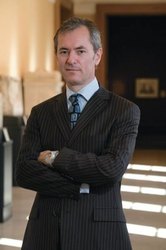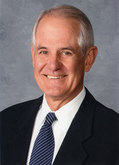 As the dust settles at the Getty Center in Los Angeles, it is interesting that few, if any, voices have been raised in support of Michael Brand (right), who stepped down as director of the Getty Museum this week. Contrast that with the aftermath of Deborah Gribbon’s 2004 resignation, when practically everyone placed the blame on Getty CEO Barry Munitz and her colleagues rallied to her support.
As the dust settles at the Getty Center in Los Angeles, it is interesting that few, if any, voices have been raised in support of Michael Brand (right), who stepped down as director of the Getty Museum this week. Contrast that with the aftermath of Deborah Gribbon’s 2004 resignation, when practically everyone placed the blame on Getty CEO Barry Munitz and her colleagues rallied to her support.
Of course, Munitz was unloved in the museum world, and not of it either — as Jim Wood (below), the current Getty CEO, is. Wood (who, btw, curiously took time during this tumultuous week to write a letter to the editor rebutting my deaccessioning op-ed, more about which soon), of course, was the longtime head of the Art Institute of Chicago. Wood retired from that job, but Chicagoans have always said, sotto voce, that he was eased out by powerful board chairman John H. Bryan.
But back to the Getty: according to my sources, neither Wood nor Brand liked one another, and Brand made no bones about that publicly. He told people. So, late last year, when Wood informed Brand that his contract would not be renewed upon its expiration at the end of this year, Brand worked out a better package and quit.
Wood, it seems, may have been meddling a bit with Brand’s acquisitions aspirations, but not without expertise and support from trustees, who wanted better oversight. They also wanted Brand to cultivate donors who would contribute art, and Brand took the Getty job thinking he wouldn’t have to do much of that, one source told me.
 When I interviewed Wood in late November, 2008, for an article that ran last January in the Wall Street Journal, he told me that he wanted the Getty branches to be more collaborative and he instituted several Management 101 practices to get them to do that — like meeting once a week and writing better mission statements. At the time, he had not planned to make budget cuts, but he reversed himself very shortly after publication (yes, I checked with the PR department right before the article ran — no changes in the budget, I was told).
When I interviewed Wood in late November, 2008, for an article that ran last January in the Wall Street Journal, he told me that he wanted the Getty branches to be more collaborative and he instituted several Management 101 practices to get them to do that — like meeting once a week and writing better mission statements. At the time, he had not planned to make budget cuts, but he reversed himself very shortly after publication (yes, I checked with the PR department right before the article ran — no changes in the budget, I was told).
Aside from Brand, the other branch chiefs don’t seem to be chafing. Some Getty staffers say Wood has started to change the nasty, competitive, infighting culture that goes back to the days of Harold Williams. They are eager to dispel the notion that the Getty is structurally ungovernable, a notion that was repeated this week in several news reports.
Yet Munitz, for one, encouraged such thinking. A 2005 article in The New York Times, for example, contains this paragraph:
‘The fact is that they are one very important piece of what we do, but they are not the ultimate decision makers.’ Mr. Munitz said of the museum’s leaders, adding that the tensions were part of ”a philosophical, organizational issue that goes back 20 years.”
It doesn’t have to be that way, insiders say — the problem is cultural, not structural, they insist. Maybe, or maybe that’s wishful thinking.
In any case, Wood and the trustees now have a difficult recruiting job, not unlike the one faced by the Guggenheim Museum, when the director was supposed to report to Foundation CEO and former museum director Tom Krens. Trustees had to change that to win over Richard Armstrong. But I don’t see that happening in Brentwood.
